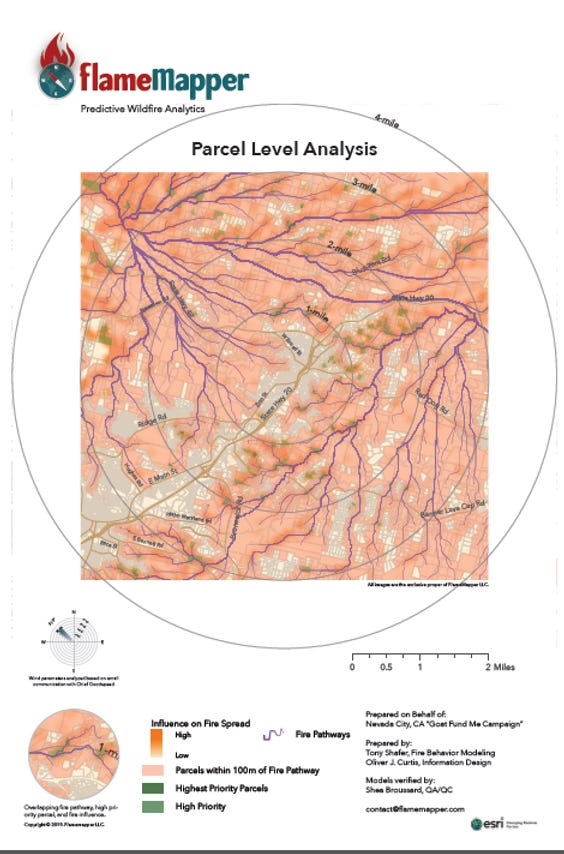As my Substack subscribers know, I believe in pointing out problems and alarming situations, but I equally believe in finding creative solutions.
I consider myself a Solutionarian.
It was in November of 2018 that the unseasonal and devastating fire known as the Camp Fire in Paradise, CA spurred me as Vice Mayor of Nevada City into finding solutions to catastrophic fires. One such solution for Nevada City became grazing goats. In April 2019, I began working on preventative measures by launching a "Goat Fund Me Nevada City" crowdfunding campaign so the city could rent grazing goats to reduce ladder fuels around our town. Because of the catchy title of Nevada City's Goat Fund Me, it received international attention for months. Here's England’s The Guardian's story, California town sets up 'goat fund me' page to finance four-legged firefighters.
Around the same time, I also brought in fire experts for a Nevada City workshop who had developed the software FlameMapper to model near-real-time fire behavior, using simulated virtual fires to understand the movement of fire and fire intensity over a mapped landscape. This could better prepare the community to identify the most vulnerable areas and the best potential evacuation routes.
However, my favorite "fire solution" was a device called a "Sound Extinguisher," as seen above in the 2019 CBS News coverage, and the video that initially caught my attention is below.
It was in 2015 when Seth Robertson and Viet Tran, two undergraduate engineering students from George Mason University, created an acoustic fire extinguisher for their senior design project.
For fire, there must be heat, oxygen, and fuel. Seth’s and Viet’s basic prototype sound wave blaster uses low-frequency bass in the 30-60Hz range. This frequency range interrupts the airflow between the fuel and flame and creates a temperature drop.
“The principle behind the extinguisher is simple: as they are mechanical pressure waves that cause vibrations in the medium in which they travel, sound waves have the potential to manipulate both burning material and the oxygen that surrounds it. If the sound could separate the two, the fire would be starved of oxygen and, accordingly, would be snuffed out. The work could potentially be applied to swarm robotics where the device would be attached to a drone to be used in situations such as large forest fires or urban blazes, thereby improving safety for firefighters.” Source.
The primary use for the sound extinguisher would be creating firebreaks that prevent fires from spreading. Sound waves would be blasted from above the fires using a swarm of drones, collecting real-time data as they went. This device could be ideal for utilizing evacuation routes near critical infrastructure and towns and reducing the overall fire heat.
My partner and I scrounged together our Southwest miles and flew Seth and Viet from George Mason University to Nevada City for a demonstration in the fall of 2019. I knew my community would have to see this to believe it. While we were able to hold the public demonstration at city hall, we were setting up prescription burns to demonstrate the device in a real-world environment when Covid hit, and since then, it has been put on the back burner. No pun intended.
Unfortunately, like the FlameMapping and Sound Extinguisher, county and city officials turned a blind eye to both potential applications. It seems more money to be made in fire suppression than prevention.
Today, the George Mason University duo is working with ARSAC with the hopes of scaling up the device to tackle large wildfires.
Does it have a way to go? Yes. But the potential is endless....
If I were Governor of California, I would be dedicated to a Research & Development Department just for the Sound Extinguisher…. just saying….
For those who have a curious mind and would like to tackle this, here’s a link to numerous studies on how to pull this off in your own garage.
Sound Fire Extinguisher's Hardware Required:
100-Watt Subwoofer
500-Watt Amplifier
Vortex tube (converging)
12 V Battery.Software
A Frequency Generator Application
Keep me posted if anyone takes on such a project.
Please share with those in fire-prone areas.
If you find these articles and videos inspiring, please become a paid subscriber for just under 17¢ daily!








Share this post